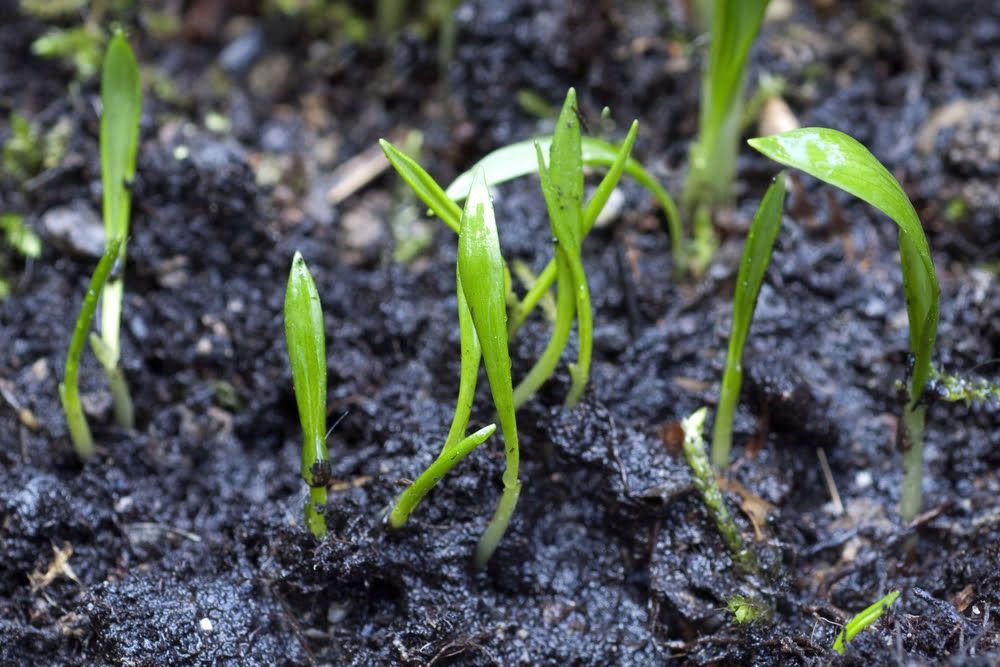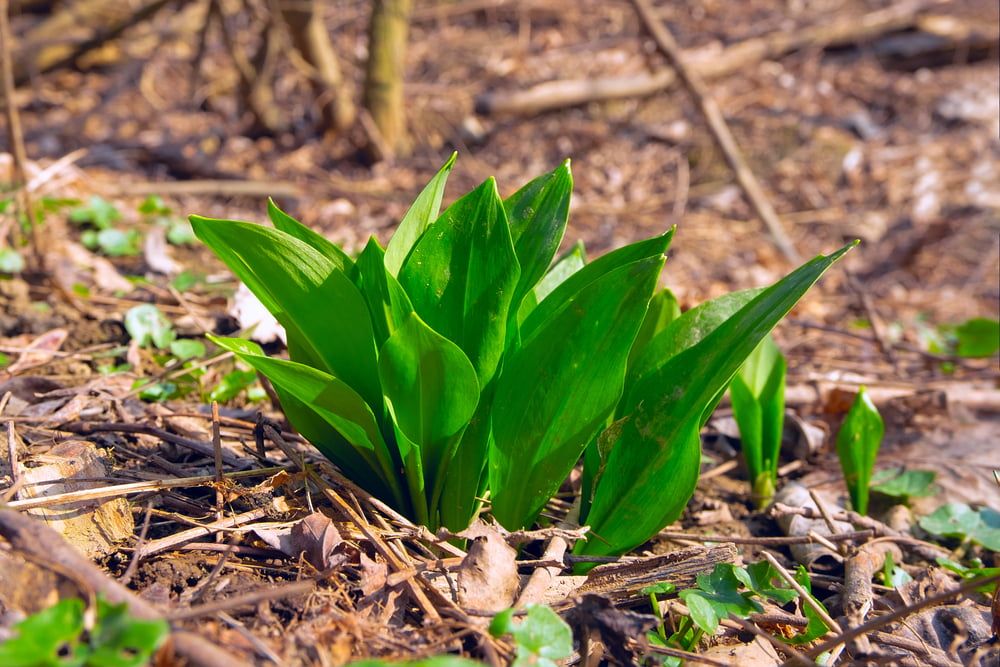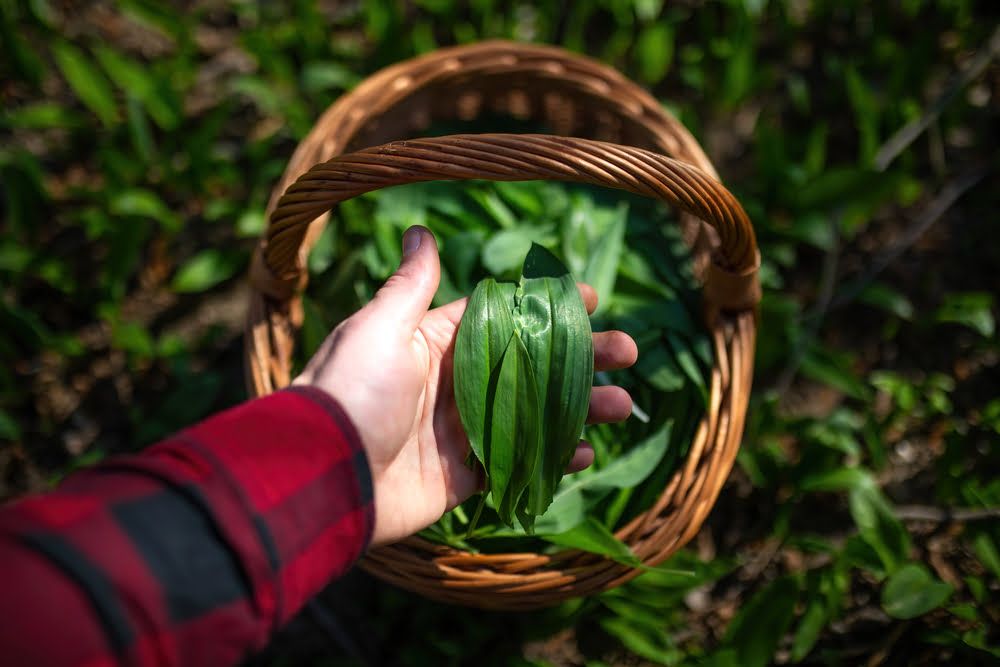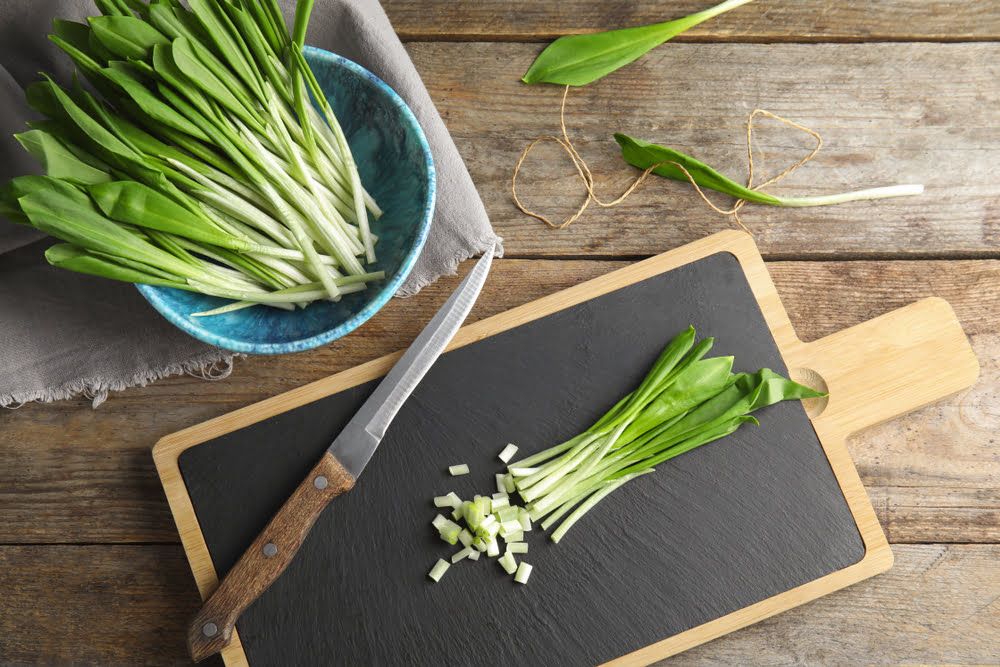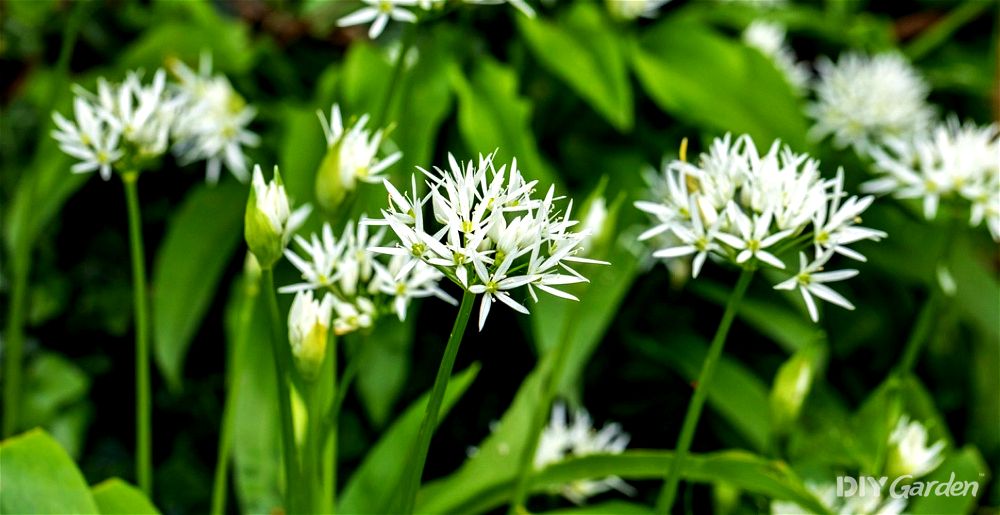
A popular springtime treat for foragers, the incredible flavours offered by wild garlic has recently brought this plant into the limelight. From the bulbs and stems to the leaves and flowers, almost every part of a wild garlic plant is edible, making it an extremely useful crop to grow in your garden. In this article I’ll teach you exactly how to grow wild garlic at home, taking it from germination to harvest!
Growing Wild Garlic: A Quick Snapshot
When to Sow – Oct-June
When to Plant – Apr-June
When to Harvest – Mar-Jun
Average Yield per Plant – 0.1kg/year
Spacing – 10cm
Depth – 1cm
How to Grow Wild Garlic at Home
While annual garlic is a popular sight in gardens and allotments, wild garlic isn’t seen quite as much. Instead, those who want to enjoy its punchy, garlicky flavour tend to forage for the plant in woodland areas. Fortunately, even if you don’t have access to a truly wild garlic patch, it’s extremely easy to grow it yourself at home, giving you your own personal supply to forage from each spring.
Growing Conditions for Wild Garlic
Wild garlic is a perennial – plant it once and it will return each year, even bigger and better than it was the previous year.
Wild garlic will thrive in the parts of your garden where other plants struggle. Placing it in a location with partial to full shade will give you the most vigorous plants. The amount of shade that you give your plants is important – don’t forget that wild garlic grows in deep and dark woodland spots. The more shade that it has, the longer your growing season will be, as hot sun causes the leaves to die back.
In terms of soil, wild garlic does best in a rich, moisture-retentive soil, but will tolerate just about every soil type.
Is Wild Garlic Invasive?
Wild garlic spreads quickly. When it’s an unwanted plant in your garden, then yes, you would probably consider it to be invasive.
However, if you’re regularly harvesting the leaves, that fast-growing habit only works in your favour. Plus, harvesting the flowers will help to prevent the plant from self-seeding, an action that heavily contributes to its invasive reputation.
Wild Garlic Bulbs vs Wild Garlic Seeds
You have two options if you want to grow wild garlic at home: plant wild garlic bulbs or start your plants from seed.
Planting bulbs is the fastest option, giving you a harvest one year after planting. If you start your wild garlic from seed, you’ll need to wait about four years before you can begin harvesting your plants.
However, just like with every plant, bulbs are more expensive than seeds. If you plan on planting a large area of wild garlic and don’t mind waiting a few years before your first harvest, then seeds are the better option.
How to Grow Wild Garlic from Seed
Wild garlic seeds can either be direct sown outside or started in pots indoors.
Direct sowing is much less labour-intensive, since you won’t need to transplant your seedlings. However, starting your seeds indoors will give you a better germination rate, as well as more control over the health of young seedlings.
Sowing Wild Garlic Seeds in Pots
Wild garlic seeds being started indoors should be sown in March.
The process is easy:
- Fill some 9cm pots with a multi-purpose compost
- Water the pots to dampen the soil
- Place 2-3 wild garlic seeds on top of the soil in each pot, spacing them out evenly
- Cover with about 1cm of compost
- Lightly water and then place in a warm location – temperatures between 15-20°C are best for germination
It takes just over a week for wild garlic seeds to germinate. Keep the soil consistently moist during and after germination.
After your seeds have germinated, make sure that the seedlings are getting plenty of light. You’ll need to keep them inside for about a month before transplanting them outdoors.
Direct Sowing Wild Garlic Seeds
Wild garlic seeds can be direct sown just about anytime between October to June, so long as the ground isn’t frozen.
Prepare your planting area by mixing organic material into the soil. This will enrich it, boost its water-retention capabilities, and also improve drainage.
Sow your wild garlic seeds about 1cm deep. Wild garlic tends to grow better in clumps, rather than in orderly rows, but try to keep your seeds about 5cm apart.
Once sown and covered over, give your seeds some water. Make sure that they remain consistently moist and you’ll soon see some green shoots appearing!
How to Plant Wild Garlic Outside
If you’ve started your wild garlic indoors in pots, then you’ll need to move your seedlings outside about one month after germination.
Here’s how to plant them out:
- Mix some organic material into your planting area – well-rotted animal manure works well
- Make small holes in the soil, large enough to accommodate each clump of seedlings. Space these holes about 10cm apart
- Carefully place your seedlings into their new homes (make sure that you don’t damage those delicate roots!) and cover back over with soil
- Immediately water well
Planting Wild Garlic Bulbs Outside
If you’ve decided to go for bulbs instead of growing your wild garlic from seed, then these should be planted either in early spring or late summer. Spring plantings usually do better – this gives the bulbs some extra time to root and spread before the cold weather arrives.
Plant the bulbs about 3cm deep, spacing them about 7cm apart. Give them some water after planting and make sure that they do not ever completely dry out.
How to Plant Wild Garlic in a Greenhouse
Although not commonly done, there’s no reason why wild garlic can’t be grown in a polycarbonate greenhouse, so long as you still give it plenty of shade. It may die back earlier due to the higher temperatures in late spring/early summer, but you’ll also be rewarded with an earlier harvest than your outdoor plants provide.
If you have raised beds or your greenhouse beds are in the ground, follow the planting steps above.
Alternatively, try growing your wild garlic in pots. This will help to contain it, ensuring that it doesn’t take over your greenhouse. Multi-purpose compost is all you need, along with pots that are about 15-20cm deep.
How to Care for Wild Garlic
Wild garlic doesn’t need much in terms of care. The rain usually takes care of its water needs, although you may need to step in with some manual watering during especially long dry spells.
If you planted your wild garlic in rich soil, a fertiliser won’t be needed either. Simply top-dress the soil each spring with some compost to give your plants a dose of new nutrients. Again, this isn’t a must.
One problem that many have is with weeds. These don’t usually cause a problem for older wild garlic plants – wild garlic is vigorous enough to drown out the weeds around it.
However, newly-planted seedlings and bulbs may struggle to root and grow properly if they’re dealing with heavy competition from weeds. Regularly weeding around your wild garlic plants is a must.
One way to reduce the amount of weeding you’ll have to do is by mulching your wild garlic. Do this in early spring, before the shoots emerge. Don’t worry about inhibiting the shoots from growing either – they’re more than strong enough to push through a layer of organic mulch. In fact, an organic mulch will slowly break down and feed your plants, which will increase growth.
How to Harvest Wild Garlic
As mentioned, every part of a wild garlic plant is edible, and also very tasty!
That being said, harvesting the bulbs themselves will prevent the plant from growing back the following year, so isn’t recommended unless you’re trying to eradicate self-sown plants. If bulbs are what you’re after, grow some annual garlic as well.
How to Harvest Wild Garlic Leaves
The leaves are the most-commonly harvested part of wild garlic. They’re at their best when they are a vibrant green shade, before the plant has started flowering. This is usually between March and June.
While the leaves can still be eaten after the plant has flowered, their flavour won’t be quite as intense.
You can either pick the leaves by hand or use a sharp gardener’s knife to cut them off. Either way, do this as close to the ground as possible without disturbing the bulb and roots. Pick only the largest and healthiest leaves, making sure that you leave some of the smaller leaves on the plant to allow it to continue growing.
As you harvest your wild garlic leaves, place them gently into a bag or basket. They bruise very easily, so handle them with care!
How to Harvest Wild Garlic Buds and Flowers
Both the buds and the open flowers of wild garlic taste delicious. These will start to emerge around April, and picking them is a great way to prevent your wild garlic from self-seeding all over your garden.
While the buds have a more delicate garlic flavour, the open flowers are noticeably stronger. They sometimes even taste more powerful than the leaves.
Simply pluck or snip off any flower stems that you see. Don’t forget that the stems can be eaten too – they have a distinct sweetness to them.
How to Store Wild Garlic
When kept in the fridge in an air-tight container, wild garlic will only store for a couple of days. This is due to its high water content. It’s best used as soon as possible after picking.
Freezing is another option, but the delicate flavour and texture of the leaves will be lost. The colour will also turn quite murky too.
Another option would be to prepare and cook all of your harvested wild garlic straight away. You can then freeze whatever you don’t eat.
How to Prepare & Cook Wild Garlic
Preparation and cooking methods will vary depending on which part of your wild garlic plants you have harvested:
Preparing & Cooking Wild Garlic Leaves
Preparing wild garlic leaves is easy. Simply give them a wash and they’re good to go.
Eat the leaves raw and their pungent garlic flavour will be instantly recognisable. However, cook the leaves for a few minutes and they lose their intensity, dulling this down to a mild yet delicious garlic/onion flavour instead.
For this reason, wild garlic leaves are treated more as a vegetable, rather than a herb or flavouring, in the kitchen.
Wild garlic leaves can be used just like spinach in the kitchen. Try stirring them into sauces, omelettes, soups, and pasta dishes to give your food a more complex flavour.
Wild garlic pesto is also extremely popular, and rightly so! You’ll find plenty of recipes online, and this is a dish that also freezes very well.
Preparing & Cooking Wild Garlic Flowers
Since wild garlic flowers are quite delicate, they are usually eaten raw. Give them a wash, break them up, and then use them as a garnish for sauces and salads.
Don’t forget that the flowers taste very strong, so you’ll need to get creative in terms of balancing out flavours.
Common Wild Garlic Problems
Thanks to its pungent smell, wild garlic rarely has to deal with any pests.
It is also very hardy and resilient, meaning that diseases aren’t usually a problem either. The main ones to look out for are:
- Rust – this is a wind-borne fungal disease that unfortunately doesn’t have a cure. Yellowing leaves combined with stunted growth are early symptoms, eventually causing the death of the plant. All infected plant parts should be removed immediately, along with any debris that infected plants shed.
- Onion rot – this disease attacks plants in the allium family, causing the stems and bulbs to turn soft and mushy. Again, there isn’t a treatment for this disease – infected plants will need to be immediately removed, along with some of the soil that surrounds them.
Popular Wild Garlic Varieties to Grow
There are a few different wild garlic varieties out there, but, other than the most common one (Allium ursinum), the others are much harder to find.
However, there are several other “wild” plants in the allium family that look and taste similar, and that you can also easily grow at home:
- Three-cornered leek
- Ramps (wild garlic that’s native to America)
- Wild onions
- Crow garlic
There’s not much that can be harvested in early spring, making wild garlic a great addition to any edible garden. The only major issue that people have is preventing the plants from spreading. However, once you taste those flavourful leaves and flowers, you’ll be wanting your wild garlic plants to grow as quickly as possible!
Where to Go Next…
Make sure you visit our ever-expanding Growing section for loads more detailed guides on growing fruit and vegetables!

